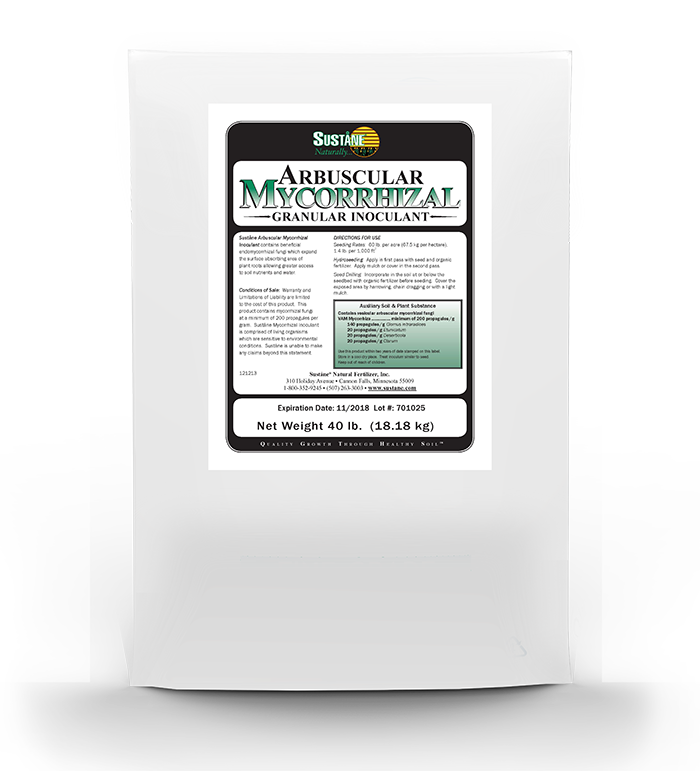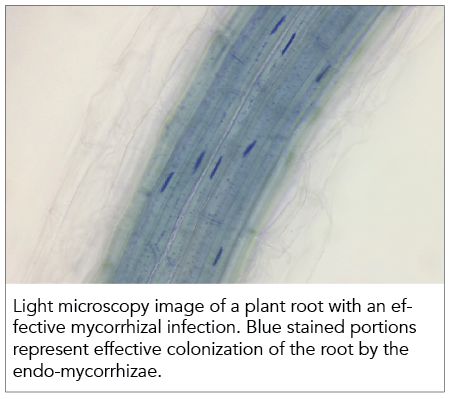
Suståne's proprietary blend of four select Endomycorrhizae species of which 85% of all plants form an association with.
Mycorrhizal fungi are used to treat disturbed soils that have been depleted of beneficial microorganisms. Mycorrhizae are major facilitators in soil microbiological processes. The addition of mycorrhizal inoculants has a positive effect on microbial populations by providing an environment for organisms that aggregate the soil, convert matter to available plant nutrients and suppress pathogens, which are generally present in higher populations when mycorrhizae are not present and when soils are compacted and anaerobic.
About Mycorrhizal Fungi:
Mycorrhizal fungi are living organisms that provide several benefits for their host plant. These organisms are entirely dependent upon their symbiotic relationship for survival and consequently provide a number of services and materials to assure their host plant’s survival and productivity. The host plant provides nourishment to the mycorrhizae through plant root exudates and sugars. While most plants form an association with mycorrhizal fungi, not all plants require mycorrhizae to survive. However most plants are more vigorous and more resistant to plant senescence when in the presence of symbiotic mycorrhizae.
Efficient use of water and plant nutrients: Upon colonization of the host plant, mycorrhizae begin to significantly increase the plant’s access to the soil resource pool by extending (literally miles of additional) microfilaments known as hyphae throughout the rhizoshpere (root zone). These threadlike structures extract both soil moisture and plant nutrients from an enlarged area and from minute sites that are inaccessible to bare roots drawing water and nutrients from a volume of soil that is 40 to 50 times greater than what the plant alone can access.
Enhanced Plant Immune and Defense System: Mycorrhizae provide access to soil nutrients such as phosphorous, calcium, sulfur, ammoniacal nitrogen and zinc. These specific plant nutrients are key to the plant’s formation of immuno-defense compounds such as alkaloids, terpenes phenols, and flavinoids. When these compounds are present at sufficient levels in a plant it has the capacity to fend off pests and pathogens.
Improved Soil Structure: As mycorrhizal hyphae develop they excrete a glue-like substance called “glomalin”. Glomalin is an important substance found in well-aggregated soils that creates additional porosity, which allows for increased movement of air, water and beneficial soil organisms throughout the soil profile. Many of the common root pathogens actually prefer waterlogged and compacted soils (anaerobic conditions). Conversely, an oxygen-rich (aerobic) soil environment created by well aggregated soils favors many of the beneficial microorganisms that assist plants in soil mineralization (of plant nutrients) and help in the suppression of plant and soil pathogens.
Rates
Apply 60 lb. per acre
Apply 7 g per 1 m2
Coverage
1.4 lb. covers 1,000 ft2 @ 60 lb. per acre
700 g covers 100 m2 @ 70 kg per hectare
Suståne has developed research-based grow programs for indoor and outdoor Cannabis cultivation. Visit our website or contact us for more information on other Suståne products for growing medical; marijuana, and hemp for fiber or CBD.
Remember that mycorrhizae require (light) coverage or soil incorporation and should form an association with living plant roots within days after incorporation.
Apply mycorrhizae with the first pass with seed and Suståne organic fertilizer (e.g. 4-6-4, 5-2-4, 6-1-3, or 8-2-4). Follow first pass application with mulch or other cover.
Top Dress: Incorporate mycorrhizae onto the soil at or below seed placement or root zone and work lightly into soil.
Seed Drilling: Incorporate mycorrhizae into the soil at or below seed placement.
Broadcast and Till: Uniformly apply organic fertilizer and mycorrhizae over the seedbed before seeding. Broadcast seed and cover the seeded area by light incorporation or surface tillage, or apply a light mulch layer over the seed and mycorrhizae.
Suståne Endo-Mycorrhizae Inoculant
(guar. min. 200 spores per gram)
Medium Grade, 200 SGN (2.8 mm - 1.4 mm)
Item #: 10-2500
Package Size: 40 lb. bags
Units / Pallet: 50 bags / pallet
Storage:
Store Suståne Arbuscular Mycorrhizal Inoculant in a cool, dry environment. Store and handle mycorrhizae as one would with seed. Use product within two years of purchase. Caution: Keep out of reach of children.

ARBUSCULAR MYCORRHIZAL INOCULANT
Auxiliary Soil and Plant Substance
Non-Plant Food
|
Contains vesicular arbuscular mycorrhizal fungi
Endo-Mycorrhizae Inoculant Rhizophagus irregularis Rhizophagus clarus Septoglomus deserticola Claroideoglomus etunicatum |
200 spores/g 140 spores/g 20 spores/g 20 spores/g 20 spores/g |

